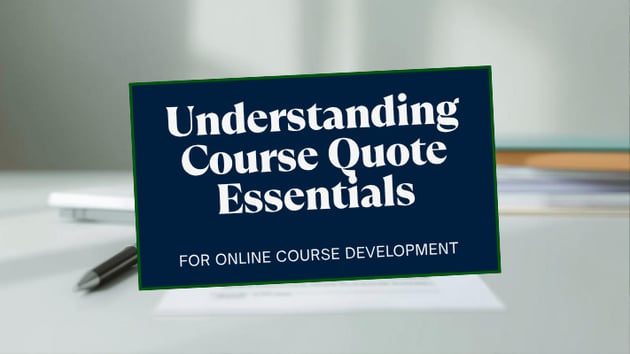Welcome to the world of e-learning design, a space where effective learning design strategies and...
How to read a quote for an online course development project (and stay in control of your investment)

When you first start looking for a supplier to help you build an online course, you quickly learn one uncomfortable truth…
The quotes can be all over the place.
Two proposals can look identical on paper. Same number of modules, same delivery timeframe. Yet one’s triple the cost. And that’s usually where the head tilt happens.
“Wait, how can they be so different?”
We see this all the time at Oppida. And here’s the thing…
The difference rarely comes down to “expensive” or “cheap” providers. It comes down to what’s inside the quote. The way effort, risk, and accountability are structured, for example.
So instead of asking “How much does it cost?” try asking “What’s driving that cost?”, and “How does it connect to real learning impact?”
That’s where the clarity (and value) lives.
So… Why do course quotes differ so much?
No two learning projects are the same. A sound proposal reflects a combination of design decisions and delivery conditions:
Complexity of learning design
Simple compliance refresher takes different work than a multi-pathway simulation.
Governance and review cycles
Every extra reviewer adds time and coordination effort.
Accessibility and compliance
WCAG standards, captioning, and QA matter for all learners.
Technology integration
SCORM, xAPI, or LMS analytics each require testing.
Media production
Video and animation can add polish, but not always value.
Common learning agency pricing models
If you’ve seen a few different agency quotes, you’ve probably noticed that they can be structured in completely different ways. Here’s how to decode them (no MBA required).
|
Model |
How it works |
Strength |
What to clarify |
|
Fixed project |
One total fee for a clearly defined scope. |
Predictable budget. |
How are revisions or scope changes handled? |
|
Milestone-based |
Payments tied to design, build, QA, and delivery stages. |
Transparency and shared accountability. |
What acceptance tests confirm each milestone? |
|
Hourly / time-and-materials |
Pay for actual hours logged. |
Flexible when scope is evolving. |
Ask for time tracking and weekly summaries. |
|
Per learning hour |
Fee per finished hour of content. |
Easy to benchmark across vendors. |
What’s included in “one learning hour” (QA, accessibility, support?) |
|
Subscription/retainer |
Monthly development allowance. |
Predictable costs for ongoing work. |
What happens if hours roll over or priorities shift? |
At Oppida, we often use fixed or milestone-based pricing because it gives both sides confidence. You see exactly what’s being delivered and when, AND we’re accountable for meeting agreed criteria before the next phase begins.
Because good partnerships aren’t about mystery, but mutual clarity.
How scope translates into cost
Let’s demystify what you’re actually paying for. When you look under the hood of a well-built course, here’s what you’ll usually find:
Curriculum design
The learning logic: Objectives, structure, assessments if applicable.
Learning design of content
- Voice, flow, tone, and alignment with your brand.
- Substantive editing of content
- Building interactions, quizzes, and accessibility features.
Media and visual design
Graphics, animations or videos to engage.
Project management
The invisible glue holding timelines, feedback, and SMEs together.
Quality assurance
Device testing, LMS compatibility, and accessibility audits.
Every one of these pieces contributes to learner experience.
But not every piece needs to be gold-plated. The art is in balancing what drives impact versus what drives cost.
Efficiency over extravagance: When less delivers more
It’s easy to equate production value with learning value, but they’re not the same thing.
For example, many teams fall into the “more media = better learning” trap. But design drives impact, not production value. Even the most stunning visuals can’t make up for content that lacks clarity or purpose.
It’s a bit like education itself. A well-run classroom doesn’t need fancy tech to achieve deep learning. It needs good pedagogy and a clear purpose.
The same is true online.
Research backs this up.
When a course is built with clear goals and smart design choices (even with simple visuals), learners are far more likely to finish and remember it. In fact, well-structured courses can see engagement and completion rates jump by up to 40%!
ROI in learning isn’t measured by how cinematic it looks. It’s measured by:
- Reduced time-to-competency: Learners reach proficiency sooner.
- Improved completion and retention: Better structure sustains engagement.
- Lower rework and support costs: Fewer questions after launch.
- Scalability: Modular design that can be repurposed across audiences.
At Oppida, we look for these efficiencies in every project. It’s how you create impact without waste.
The best courses don’t succeed because they’re expensive.
They succeed because they’re clear, intentional, and deeply relevant to the people who take them.
The procurement mindset (minus the bureaucracy)
Even if you’re not in government or higher ed, it helps to think like a procurement officer. Why? Because they’re trained to look past the headline number to what’s being delivered.
They ask:
- Are milestones clearly defined?
- Are deliverables tied to payments?
- Are acceptance criteria measurable?
- Who owns the intellectual property?
- How is accessibility handled?
Those questions protect both parties. And when you start asking them too, you stop feeling like a “client” and start acting like a partner.
Oppida’s proposals always include these elements, not because they’re bureaucratic, but because they give everyone peace of mind. When the rules of the game are clear, everyone wins.
Smart questions to ask any vendor
Here’s your quick “vendors cheat sheet” for your next course quote:
- What’s included and excluded from the scope?
- How will we handle feedback and revision rounds?
- What does “acceptance” look like before payment?
- Do we retain ownership of the source files?
- Is accessibility built in from the start or added later?
- How do you measure success post-launch?
Good agencies love these questions. It means you’re serious about outcomes, not just deliverables.
Make ROI your North Star
If there’s one takeaway, it’s this:
Your goal isn’t to build a course. It’s to create impact.
Return on investment in learning isn’t a mystery. It’s the relationship between what you spend and what you achieve:
- Faster onboarding.
- Improved learner confidence.
- Fewer compliance gaps.
- Better performance in the real world.
Studies from ATD and Training Industry show professionally designed learning can deliver up to 300% ROI over three years. Not because it’s prettier, but because it’s purposeful, accessible, and reusable.
At Oppida, that’s our compass. Every decision (design, media, delivery) gets weighed against one question:
“Does this make learning more effective or just more expensive?”
The Oppida Way: Transparency, not templates
Across projects big and small, we’ve learned that clarity is the most powerful currency.
We work milestone by milestone, so you know exactly what’s being delivered and when. We co-design alongside your team, so you build capability, not dependency.
We build accessibility in from day one.
And we hand everything over (source files, documentation, design systems), so your learning investment keeps paying forward.
That’s how you stay in control.
That’s how you make every dollar, and every decision, count.
If you'd like to learn more about how we collaborate, book in a quick discovery call for a chat!
Clarity is your safest investment
A course quote isn’t just a number, but a reflection of what’s valued, and seeing proposals through the lens of ROI changes everything.
You start to value clarity more than complexity, purpose more than polish, and partnership more than paperwork. As a result, your decisions become smarter, braver, and far more sustainable.
So the next time a proposal lands in your inbox, take a deep breath, grab a coffee, and ask:
“Does this investment lead to impact?”
If the answer’s yes, you’re on the right track!
Ready to see what transparent scoping looks like?
Book a short conversation with the Oppida team.
We’ll walk you through how a course proposal is structured (milestones, deliverables, and acceptance criteria), so you can make decisions with clarity, confidence, and control.
References
- https://www.leadinglearning.com/cost-to-create-e-learning/
- https://raccoongang.com/blog/how-much-does-it-cost-create-online-course/
- https://bluecarrot.io/blog/e-learning-content-development-cost-per-hour-explained/
- https://www.learnworlds.com/how-much-does-it-cost-to-develop-an-online-course/
- https://www.learnexus.com/instructional-design-pricing
- https://elearningindustry.com/hidden-elearning-costs
- https://elearningindustry.com/prove-training-roi-top-content-providers-list
- https://www.trainingindustry.com/articles/content-development/the-hidden-costs-of-elearning/
- https://www.td.org/content/press-release/atd-research-optimism-remains-strong-for-future-of-learning-in-organizations
- https://www.getadministrate.com/resources/guides/learning-and-development-trends-report-2024/
- https://elearningindustry.com/roi-of-elearning-measuring-training-effectiveness
- https://www.coursearc.com/digital-accessibility-essentials/
- https://www.w3.org/WAI/standards-guidelines/wcag/
- https://www.absorblms.com/blog/the-essential-guide-to-lms-pricing/
- https://www.ispringsolutions.com/blog/lms-pricing-guide
- https://elearningindustry.com/best-elearning-authoring-tools-and-course-creation-software
- https://www.truefan.ai/blogs/e-learning-authoring-tools-guide
- https://aicoursecreator.eskilled.io/blog/the-best-rapid-elearning-authoring-tools-in-2025/
- https://www.consultingsuccess.com/consulting-fees
- https://www.scoro.com/blog/pricing-models/
- https://legittai.com/blog/milestone-based-payments-in-contracts
- https://strategicinstitute.org/other-transactions/milestone-payments/
- https://centreforinclusivedesign.org.au/accessibility/pcwa/
- https://theweco.com/weco-learning/
- https://www.adb.org/sites/default/files/abnormally-low-bids.pdf
- https://influencermarketinghub.com/payment-terms-milestone-schedules-influencer-briefs/
- https://kineo.com/en-au/resources/elearning-examples-from-kineo


